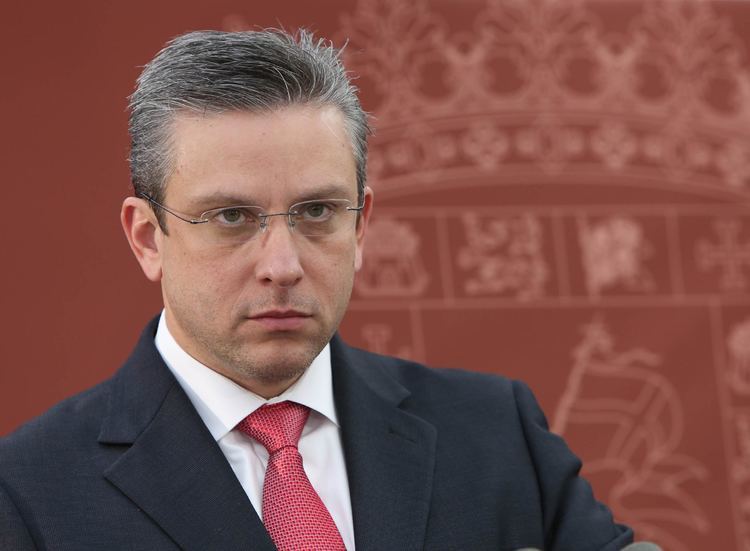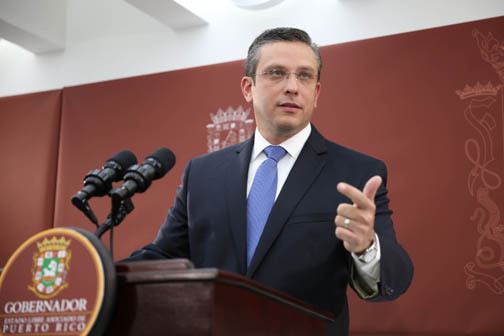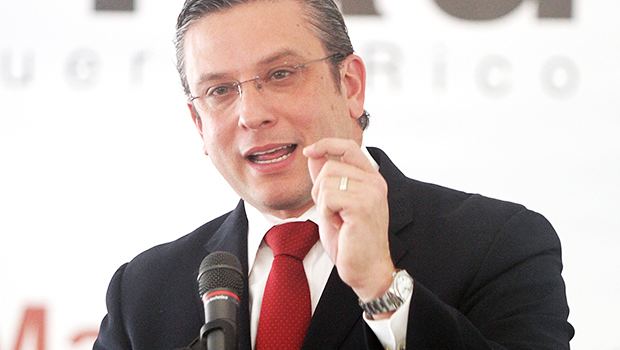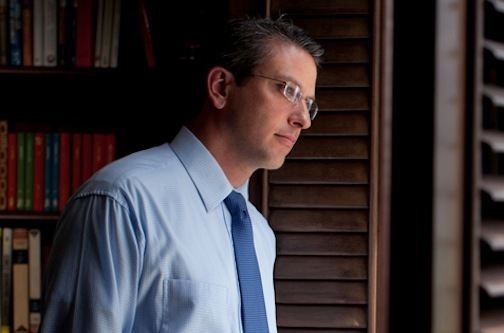Preceded by Luis Fortuno Name Alejandro Padilla Succeeded by Luis Rivera Marin | Website Government website | |
 | ||
Full Name Alejandro Javier Garcia Padilla Residence La Fortaleza, San Juan, Puerto Rico Children Diego Padilla, Ana Patricia Padilla, Juan Pablo Padilla Similar People Luis Fortuno, Wilma Pastrana, Luis Munoz Marin Profiles | ||
Puerto Rico Governor: 'We are out of cash'
Alejandro Javier García Padilla ([aleˈxandɾo ɣarˈsi.a]; born August 3, 1971) is a Puerto Rican politician and attorney who served as the 11th Governor of Puerto Rico from 2013 to 2017. Prior to this position, García Padilla held various roles in the political landscape of Puerto Rico; first as Secretary of Consumer Affairs, and then as a member of the 24th Senate of Puerto Rico and as president of the Popular Democratic Party. Locally, he is a staunch advocate for maintaining the current political status of Puerto Rico as that of an unincorporated territory of the United States with self-government, while at the national level he is allied with the Democratic Party.
Contents
- Puerto Rico Governor We are out of cash
- Alejandro garcia padilla aprende hablar ingles con sigui mi
- Early years
- Professional life
- Political career
- Gubernatorial campaign
- 2012 elections
- Transition
- Inauguration
- First days
- Domestic policies
- Foreign policies
- Public image and perception
- Personal life
- References

As governor, García Padilla shared his legislative powers with the 25th Senate and 29th House of Representatives, both controlled by his party. Regardless of this, he was not able to persuade several members of his own party to support his proposals. This failure, in addition to his low popularity, ultimately led him to not seek re-election thus becoming the second governor in Puerto Rican history to not do so after his first term.

Alejandro garcia padilla aprende hablar ingles con sigui mi
Early years

García Padilla was born on 3 August 1971 in Coamo, Puerto Rico to Luis Gerardo García Sánchez (1927-2005) and María de los Ángeles Padilla Passalacqua and is the youngest of six brothers including Juan Carlos and Antonio. His father Luis, a World War II veteran, held various jobs throughout his life to support his family, including machinery operator, and returned from the war to become a general manager of a manufacturing company. His mother has been a dedicated homemaker. He is of paternal Asturian descent with his grandfather Carlos Garcia Cadorniga born 1890 in Navia, Asturias, Spain who settled in Ponce. He also has Corsican lineage from his maternal great-great grandfather.

García Padilla was raised in Barrio Cuyón in his hometown. He attended the Colegio Valvanera High School. After graduating, he obtained his bachelor's degree in Political Science and Economics from the University of Puerto Rico, and a juris doctor from the Interamerican University of Puerto Rico School of Law. García Padilla is the first and only governor to be entirely educated in Puerto Rico, and the first and only governor who has resided only in Puerto Rico during his entire life. He is also the first and only governor born in a rural municipality.
Professional life

García Padilla began his law career working at Puerto Rico's Court of Appeals as a law clerk. He then worked as an attorney, specializing in Property, Estates, Contracts, and Administrative Law. He also worked as a law professor at the Interamerican University. He later served as a legislative aide for the committees on Internal Affairs, Women's Affairs, and Agriculture, among others. He was a member of the board of the Puerto Rico Bar Association.
Political career

In January 2005, García Padilla was confirmed as Secretary of the Puerto Rico Department of Consumer Affairs under the administration of Aníbal Acevedo Vilá. During his tenure at the agency, he was known for his credibility, accessibility and aggressive fiscalization. In 2007, García Padilla resigned his position as Secretary and announced that he would run for Senator.

In the 2008 general elections, he received the highest number of votes among all senatorial candidates. After the election, he was selected by José Dalmau Santiago, Senate Minority Leader, to serve as the ranking member on several committees, including Governmental Affairs, Public Safety, and Judicial Affairs.
Gubernatorial campaign
On 6 March 2011, García Padilla announced his plans to run for Governor of Puerto Rico in 2012. He also announced his candidacy for President of the Popular Democratic Party, running unopposed, and took office on 4 April 2011. On 26 October 2011 he named Rafael Cox Alomar as his running mate for Resident Commissioner (who went on to lose the election by a 1.28% margin), replacing Héctor Ferrer Ríos, who withdrew from the congressional race in order to run as the PPD's candidate for Mayor of San Juan.
2012 elections
After the 2012 gubernatorial elections of 6 November 2012, García Padilla was elected as the next Governor of Puerto Rico, by a narrow (0.6%) margin, defeating incumbent Luis Fortuño 47.73% to 47.13%.
Transition
Puerto Rican law requires that a formal process is followed when the government must transition from one Governor to another. As such, García Padilla formed the 2012 Incoming Committee on Government Transition composed of aides and advisors who would eventually become part of his Cabinet.
Inauguration
García Padilla was officially inaugurated as the 11th Governor of Puerto Rico on 2 January 2013 by Federico Hernández Denton, Chief Justice of the Supreme Court of Puerto Rico, at an event held in the Puerto Rico Capitol. He will serve as governor concurrently with the 16th Cabinet of Puerto Rico and in parallel with the 17th Legislative Assembly of Puerto Rico, the 25th Senate of Puerto Rico, and the 29th House of Representatives of Puerto Rico.
First days
García Padilla formed a cabinet composed of former aides and members of the private sector to form the 16th Cabinet of Puerto Rico. He holds office in parallel with the 17th Legislative Assembly of Puerto Rico, the 25th Senate of Puerto Rico, and the 29th House of Representatives of Puerto Rico. His primary challenge will be taking a government with a large indebtness and high deficit. His first executive orders were proclaimed on 3 January 2013, one day after being sworn in. One of them activated the Puerto Rico National Guard to monitor Puerto Rico's coasts and ports in order to reduce illegal immigration and the flow of illegal goods into the island, while another established that the Puerto Rico Chief of Staff must be consulted before making any appointments to empty seats, issuing contracts or amending existing contracts. The third executive order was proclaimed to control spending in agencies with credit cards, phones, escorts, official cars, overseas travel, and cell phones and personal digital assistants.
Domestic policies
On 30 June 2013, García Padilla signed the Redistribution and Tax Charge Adjustment Act of 2013 (Act No. 40 of 2013) reducing the portion of the Puerto Rico Sales and Use Tax that municipalities charge from a 1.5% to 1.0%—effectively lowering the total sales tax from 7.0% to 6.5%. However, this change has not yet been reflected, and the sales tax rate of 7.0% remains. The Act also expanded the use tax to include more services, including business-to-business sales and services like consulting. Under his administration, a new tax of 4 cents per liter was imposed on gasoline.
As part of his economic policies, García Padilla launched an austerity programme, raising taxes by 1.1% of the gross national product (GNP) and making public employees’ pension schemes less generous. These measures are expected to trim the government deficit from $2.2 billion to $800 million. This, according to The Economist, has made 62% of Puerto Ricans disapprove of García Padilla.
On June 28, 2014, Governor García Padilla signed into law the Puerto Rico Public Corporation Debt Enforcement and Recovery Act, which sought to allow corporations owned by the Commonwealth, such as the Puerto Rico Electric Power Authority, the Puerto Rico Aqueducts and Sewers Authority, and the Puerto Rico Highways and Transportation Authority to declare bankruptcy. However, in February 2015, U.S. District Judge Francisco Besosa found the Act was void because it was preempted by the U.S. Bankruptcy Code. In July 2015, that ruling was affirmed by the United States Court of Appeals for the First Circuit, with Judge Juan R. Torruella concurring only in the judgment. The following June, in Puerto Rico v. Franklin California Tax-Free Trust (2016), that ruling was additionally affirmed by a U.S. Supreme Court in a vote of 5-2, with Justice Sonia Sotomayor dissenting.
Facing the Puerto Rican government-debt crisis, in June 2015, Governor García Padilla announced the Commonwealth was in a "death spiral" and "the debt is not payable."
On June 30, 2016, President Barack Obama signed the PROMESA into law, which empowered him to appoint a seven-member Financial Oversight and Management Board that has ultimate control over the Commonwealth's budget.
Foreign policies
In June 2013, García Padilla traveled to Spain where he met with representatives of the pharmaceutical and medical devices industry of Spain to showcase Puerto Rico as an attractive investment destination.
In July 2013, García Padilla's administration established a trade agreement between Colombia and Puerto Rico whereby Colombia will import medicine from Puerto Rico and provide knowledge transfer in several industries. Puerto Rico on the other hand will co-manufacture products together with Colombia, so that Colombia can benefit from Puerto Rico's lack of tariffs when exporting to the United States.
Public image and perception
On 4 August 2013, protesters marched in Old San Juan to express their discontent with new taxes imposed by his administration and the way the government has been handling its finances.
On 6 November 2013, El Nuevo Día released poll results published a year after his election that indicated that 57% of poll participants rated García-Padilla's administration with a "D" or an "F" grade and 62% disapproved of his performance as governor.
He has also been accused of nepotism, because of his having five relatives working in the government, three of them as political appointees. Most of the criticism was focused on the appointment of his cousin, Ricardo Colon Padilla, as director of the commonwealth's Medicaid program, as Colon been previously convicted of providing the FBI and IRS with false testimony during an investigation.
Garcia Padilla has been criticized by some Puerto Ricans for his poor command of the English language, marked by stammering, poor vocabulary, a strong accent, and difficulty in understanding the language. He has tried to shake off criticism of his language skills by appealing to populism, stating that he is proud of his rural origins, and that his English reflects said origin, and that he also "speaks better English than a mainlander speaks Spanish."
On 14 December 2015 after weeks of speculation and due to opposition from his own party, García Padilla announced he wouldn't seek re-election.
Personal life
García Padilla has been married to Wilma Pastrana, a CPA, since 7 April 2001. They have three children: Ana, Juan Pablo, and Diego. Among his older brothers, Antonio served as President of the University of Puerto Rico and Juan Carlos serves as mayor of Coamo. Another of his brothers, Luis Gerardo, was a government employee with the Puerto Rico Telephone Company.
